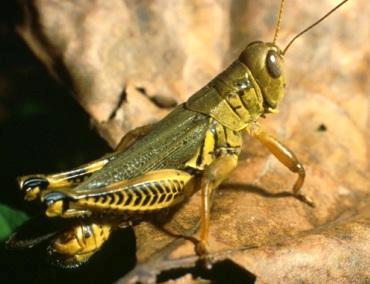|
Grasshopper
View more pictures: Bing Images Google Images Yahoo Images Common names: Grasshopper, Locust Scientific name: Acrididae Region: This insect pest is found throughout North America in various species. Life cycle: This insect produces one generation each year and overwinters in the egg stage. Physical Description: This 1 to 2 inch long insect is brown, green, or reddish yellow, with a long body, short antennae, enlarged hind legs for jumping, and powerful jaws. Its eggs are laid in pods within the soil or weeds. Feeding characteristics: The grasshopper (GH) will attack most vegetable crops by feeding during the day on the leaves and stems. During dry spells, they can defoliate plants. The most troubled are rangeland, wheat, corn, barley, oats, rye, and alfalfa. Controls: It has many natural controls, including birds, animals, parasites, and other insects. A layer of compost or mulch will help keep it from surfacing in the spring. If some make it through, those that do will become prey to such birds as crows, meadowlarks, hawks, brown thrashers, killdeer, catbirds, mockingbirds, sparrows, bluebirds, and flycatchers. A number of animals will eat them, such as, cats, skunks, toads, coyotes, snakes, spiders, and guinea hens. Flesh Flies insect will deposit maggots onto them. The tiny maggots bore their way into the body and feed on the contents, leaving the most vital organs for last. When there is an abundance of Flesh Flies and they can greatly reduce the number of this pest and the egg laying. The Nosema locustae is a protozoan parasite, which is now on the market. It's used throughout Idaho and Montana to control this pest on rangeland. The Tanglewing Flies lay eggs by the thousands on upright wood structures that hatch tiny maggots that blow in the wind and land on grass-hoppers. How they find the grass-hoppers is unknown, but they do. They also bore into the body and eat its contents until they kill the GH. Once fully grown the maggots force their way back out and goes into the ground and changes into a pupa only to emerge as an adult fly a few weeks latter. Bee Flies, Margined Blister Beetles, and Ground Beetles lay their eggs close to the GHs' eggs and their hatching larvae eat the pods of GH eggs. Other insects, such as Red Mites, which sucks the contents of the eggs, and spiders that trap adult GHs in their webs, also help control the numbers. Ground squirrels, field mice and other rodents eat GHs and dig around for their eggs. There are other types of controls that you can use to reduce the grasshopper problem in your area. If you are infested right now, try a hot pepper spray, consisting of hot-pepper pods, soapy water, proportions are up to you. You can also trap a good deal of GHs in your garden by burying two quart mason jars partly filled with one part molasses to ten parts water in the ground of your garden. Return from Grasshopper to Insects E-H Encyclopedia of Garden Insects |
